by tmoffett | Jul 19, 2012 | Black and White, Color, Composition, Photographic Technique
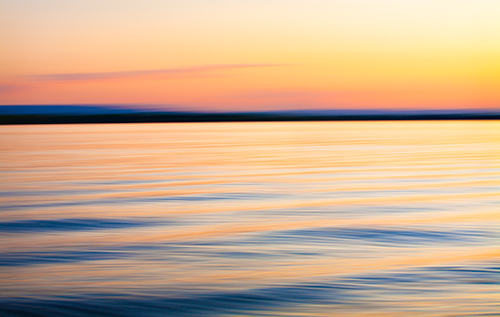
Complementary Reflections
It seems kind of strange to me to be talking about color. My photographic roots are in black and white. Before digital came into play, all of my personal work was black and white. I wouldn’t even carry color film with me. I loved what I could do with black and white. The entire process from shooting to processing to printing was fascinating to me. Expanding or compacting the tonal range of a scene and moving the tones to where I thought they should be was what I loved. I felt in complete control of the scene I was photographing. Then came digital.
The changes that digital brought along have been significant to me. I won’t go into them all now, that is for another time. The one change that I will discuss, though, is how it has affected my use of color. I still like to print in black and white, but I have added color as well to my repertoire.
Photographing in color first, and then converting the image to black and white, I began noticing how color could affect an image. I began studying the color composition of each of my photographs before converting them to black and white, and soon I began looking at the color in a scene and analyzing it before pressing the shutter. Little by little, color photographs began appearing in my portfolio. Now, it seems, that only those very special images make it to black and white.
The image above, Complementary Reflections, is one where color is everything. Without the color, the photograph would be a complete failure. The cool tones of the eastern sky reflecting in the water filled with the warm colors from the setting sun creates a feeling of excitement in the image that draws me in. When making this photograph, I got an idea to do a series of abstract images about color. Most of the photographs in the series so far I have made at the ocean, but occasionally I find just the right conditions on a lake or other body of water to photograph this way. It is fun and exciting to evolve and change. This change, to photograph in color, never would have happened for me if I had resisted the move to digital capture. It has been challenging at times, but always exciting!
This photograph also appears in my book Silent Solitude.
by tmoffett | Jun 11, 2012 | Black and White, Landscape, Photographic Technique
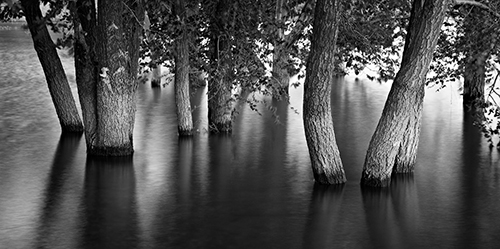
High Water Reflection, Lake Lowell
I just received my new Canon 5D Mark III and had time to go out and test shoot at the lake. I wasn’t really expecting great images, as I wanted to run some tests before using it for a “real” shoot. After looking at the files, I must say that I am quite impressed. Canon has done some great things with this camera.
I have always shot at 100 ISO to keep noise to a minimum, but after shooting a few images after sunset at higher ISO’s, I would not hesitate to use ISO 800 for fine art images. I even had to look hard to find noise at 1600. For sporting events where a little but of noise is acceptable, I would not hesitate to shoot at 25600. The noise structure at higher ISO settings was quite remarkable.
Previous to this camera I have never used auto focus, but after trying out the 61 point auto focus system, I think I might become converted! The ease of changing focus points makes it almost a no-brainer. There are occasions, however, that there is not a focus point far enough off center so that I will have to focus manually. When photographing the landscape on a tripod, for me this does not present much of a problem.
One feature that I really like is the electronic level. I found it to be very accurate and speeds up the framing process. I was composing one image that I was sure I had level, but when checking the electronic level, found that my eye was way off. I photographed both ways, and upon further inspection, found the camera’s level to be correct.
I have not put the camera through a test of all functions yet, but for what I have done, I know that I am going to like it. I can’t wait to get out later this week and continue working with this new tool.
The image posted was made on a windy evening at Lake Lowell at a location that I have photographed many times, but never quite like this. It always amazes me that there is something new to find each time I return to a familiar place. I somehow never tire of this place. Maybe it is that I never tire of photography and am always looking for something new. Training ourselves to see is such an important part of being a photographer. It is not so much training, but becoming aware of our surroundings and seeing life as it unfolds. As we become sensitive to our environment, then the images seem to reveal themselves. It is a wonderful experience to be a part of.
by tmoffett | May 29, 2012 | Color, Landscape, Photographic Technique
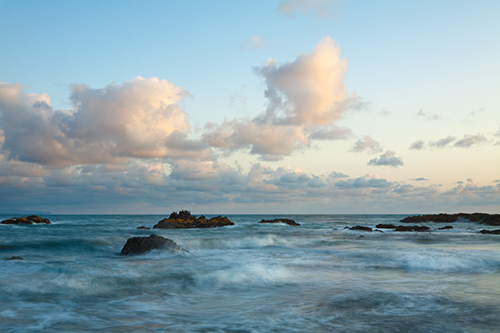
View from Cobble Beach, Newport, Oregon
I don’t know why, but I am really drawn to the water. Any water. Rivers. Streams. Lakes. But mostly the ocean. I am in the middle of giving final exams in my classes and I am really wishing I was at the beach with my camera instead. It doesn’t help matters that everywhere I turn I have photographs reminding me of how much I enjoy the coast.
One reason, I think, that I enjoy photographing moving water so much is the variety that it offers. You can stop the waves and capture every droplet of water as it sprays toward the shore, you can slow things down and capture the flow of the water over the rocks, or you can go anywhere in between. What I am feeling at the time usually dictates how I see the water and how I will photograph it. I often teach, especially in my beginner courses, to experiment with different exposure settings to see what happens to the image. I rarely do much experimenting when out photographing. I see what I see, my vision, and that is what I photograph. In earlier days I did the experimenting. I learned what happens when I use a long shutter speed. I learned how fast I needed to shoot to stop the water in a fast-flowing river. Now I spend more time experiencing the scene and then photographing it the way I feel it to be. The techniques have become my tools. I use these tools to create images resembling my vision. The tools enhance my creativity.
This particular evening at Cobble Beach, I met the Park Ranger as I was descending the steps to the beach. I was informed that I must be off the beach 10 minutes before sunset and out of the park 10 minutes after sunset. This threw a damper in my plans, as I love photographing long after the sun goes down. I felt rushed to get what I wanted, and upon reviewing my photographs from that evening, I think it affected me. Instead of creating soft, flowing images of a relatively smooth sea, I found myself using an “in between” shutter speed that would enhance the waves and make the scene appear more turbulent than maybe it really was. All of my exposures showed that look and feel. It was definitely different than what I shot the rest of that trip. It was proof to me that my emotions do affect the way I see, and therefore the way I photograph. I like it that way!
by tmoffett | May 22, 2012 | Color, Landscape, Photographic Philosophy, Photographic Technique
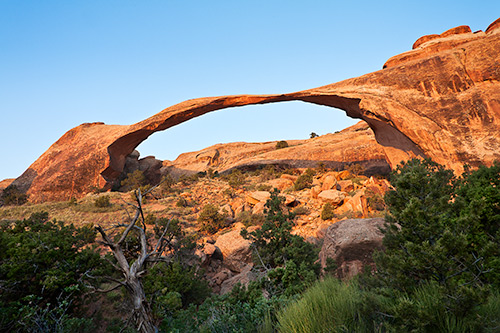
Landscape Arch, Arches National Park
My life can get quite crazy when on a photography trip. I arise early, oftentimes 4:00 A.M. or earlier and head out to a predetermined location. Frequently a pre-dawn hike is required and I arrive in plenty of time to prepare for sunrise. I never like to be rushed. Photography for me is not a job, it is an experience, and one to be enjoyed! Once I arrive at a location, I try never to hurry, I observe, I meditate, I let all of my senses go to work so that I can fully experience where I am. Only after I find myself can I really create an image that will have any impact at all. Once I have determined what it is that I will photograph and how I will photograph it, I set up and wait. As the sun nears the horizon, the light quality gets better and better, then all at once it becomes great! I shoot away, making subtle adjustments between exposures until everything is just right, then nearly as quickly as it came, the light is gone. Sometimes in the morning, the real good light only lasts a few short minutes, then it becomes harsh and uncontrollable. All of this effort for sometimes a mere five minutes of great light. Worth it? Absolutely! So much so that I turn around and do the same thing in the evening.
Evening photography is a little different than sunrise photography. The light quality stays good for me longer in the evening than in the morning, mostly because I love the light after the sun sets. I often, during the summer months, will shoot until after 10:00. This makes for some really short nights, but very much worth it in my opinion. I do need a few days to recover after returning home from a photography “vacation.” Why do I do it? It is who I am. I love photography, and great photographs are made at the ends of the day. I once heard a friend respond to someone questioning why it was necessary to get up so early. His response was that “At five o’clock you’re a photographer but at 11:00 you’re just another tourist.” How true that is. Avoiding tourists and enjoying the sights in a kind of light that you will never find at mid-day is part of what drives this passion of mine.
by tmoffett | Apr 12, 2012 | Color, Landscape, Photographic Philosophy, Photographic Technique, Uncategorized
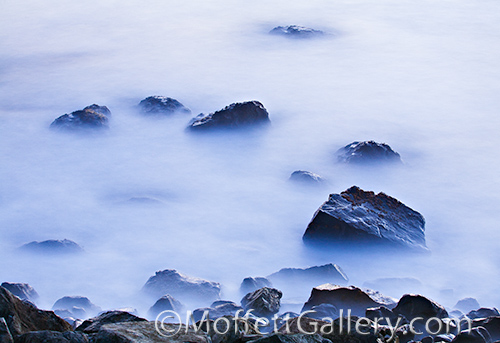
Sea of Mist
I have often said that my favorite time to photograph is just after the sun has set. Well, often I will shoot long after the sun has gone down. This image is one of those times.
It is interesting to me that as many photographers are packing up and going home, I am often just getting started. I like what happens when long exposures capture objects lit with the delicate light coming from the moon. This photograph which is part of my “Shorelines” portfolio, was taken with nearly a 2 minute exposure. The rocks remain tack sharp while the ocean waves crashing ashore become like a sea of mist, soft and delicate. I love how the moisture on the rocks reflects the moonlight and really do look wet, so wet that you can almost feel it when you view the picture. There is also a gentle color shift that I find quite captivating. When I think of the ocean, this is what I see.
If you are a photographer, try not doing a custom white balance sometime. You might just like it! A custom white balance is meant to neutralize the color, making everything look normal, but who is to decide what normal really is. I photograph in this kind of light because of the color, so why would I want to neutralize it? Keeping my white balance in one of the daylight modes will render the colors more closely to how I visualize them instead of removing the color cast caused by the real color of the light that exists, making them appear “normal,” or neutral.
by tmoffett | Apr 3, 2012 | Color, Composition, Landscape, Photographic Technique
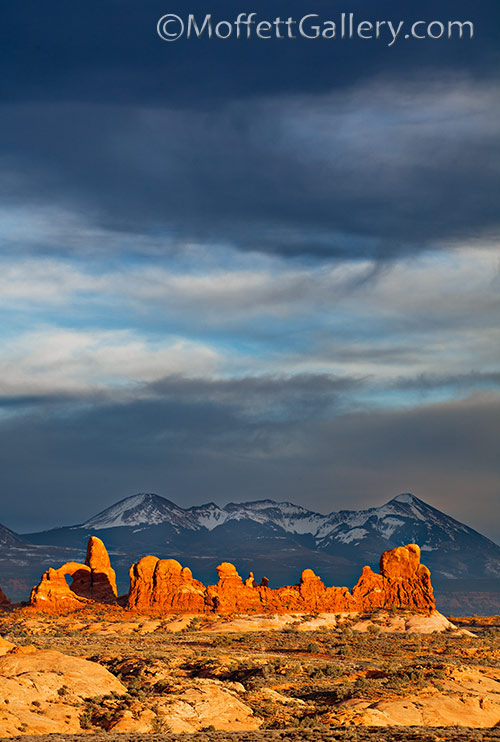
Arches National Park, Moab, Utah
As a landscape photographer I chase light. I have found that when the light quality is great, the resulting photograph will be great. The contrary is also true. If light quality suffers, so will the photograph, even if the location and composition are great. Add great composition to great light and it gets even better, then add emotion and the image becomes spectacular.
All last week I spent in the Moab, Utah area. Arches National Park, Canyonlands and Dead Horse Point all offer interesting subject matter for photographers. The difference maker for good or great photographs becomes light quality. All week long the light quality was good at best, not great. Then the last evening I was there, everything set up quite nicely. Dark clouds began to move in to the east. Heavy clouds were in the west interfering with the light, but there was a small band of clear sky between the horizon and the cloud cover. I watched and waited, knowing that just before sunset, the sun would break out and bathe the rock formations to the east with warm light. I was not disappointed, it happened just as expected. Photographers all over the park were treated to a scene that does not frequently occur. I was in in awe. It lasted only a few minutes and was gone. That few minutes is what being a photographer is all about.








Recent Comments